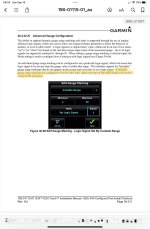According with the latest G3X Touch software updates I would like to configure a Take-OFF Configuration Warning for trims, flaps etc triggered by take off power set.
For example; I want the Trim out of range warning to come up when the following conditions are met:
1. Aircraft on ground (AGL)
2. Airspeed below 55kts
3. RPM above 2350 (warning is active with take off power only)
4. Trim out of Take Off range
Same for flaps, if Flaps > 15
-is this possible?
For example; I want the Trim out of range warning to come up when the following conditions are met:
1. Aircraft on ground (AGL)
2. Airspeed below 55kts
3. RPM above 2350 (warning is active with take off power only)
4. Trim out of Take Off range
Same for flaps, if Flaps > 15
-is this possible?


